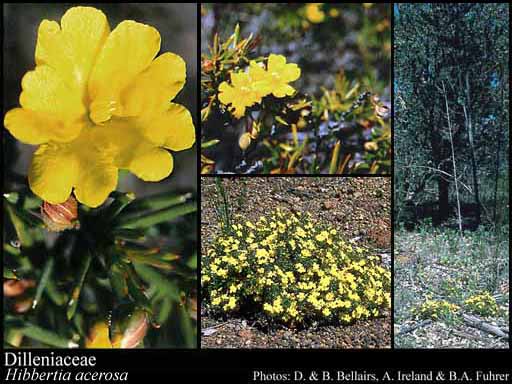- Reference
- Parad.Lond. pt.73 (1807)
- Name Status
- Current







Scientific Description
Common name. Dillenia Family.
Habit and leaf form. Trees, shrubs, and lianas, or herbs (a few), or herbaceous climbers; usually deciduous. ‘Normal’ plants, or switch-plants (occasionally); switch plants with the principal photosynthesizing function transferred to stems. Leaves well developed (usually), or much reduced. Plants with a basal concentration of leaves (sometimes), or with neither basal nor terminal concentrations of leaves. Self supporting, or climbing; sometimes stem twiners. Hibbertia recorded as reversibly twining clockwise, or twining anticlockwise. Sometimes leptocaul. Mesophytic, or xerophytic. Leaves alternate (usually), or opposite (rarely); usually spiral; leathery (often), or ‘herbaceous’, or membranous; petiolate; sheathing, or non-sheathing; gland-dotted, or not gland-dotted; simple. Leaf blades entire (usually), or dissected (occasionally lobed); one-veined, or pinnately veined, or palmately veined. Leaves with stipules (the stipules winglike, adnate to the petiole), or without stipules. Leaf blade margins entire, or serrate. Leaves without a persistent basal meristem. Domatia recorded (from two genera); represented by pockets, or hair tufts. Stem anatomy. Nodes unilacunar, or tri-lacunar, or penta-lacunar to multilacunar. Secondary thickening developing from a conventional cambial ring, or anomalous (rarely?); when anomalous, via concentric cambia (Doliocarpus).
Reproductive type, pollination. Fertile flowers hermaphrodite. Unisexual flowers absent. Plants hermaphrodite.
Inflorescence and flower features. Flowers solitary, or aggregated in ‘inflorescences’. The terminal inflorescence unit (when flowers aggregated) cymose, or racemose. Flowers small to medium-sized (usually), or large; regular to somewhat irregular. The floral asymmetry when noticeable, involving the androecium. Flowers partially acyclic. The perianth acyclic, or the androecium acyclic, or the perianth acyclic and the androecium acyclic. Floral receptacle not markedly hollowed. Free hypanthium absent. Hypogynous disk absent. Perianth with distinct calyx and corolla; (5–)10(–25). Calyx (3–)5(–20); polysepalous; spirally imbricate; fleshy, or non-fleshy; persistent. Corolla (2–)5; polypetalous; imbricate, or crumpled in bud (often); white, or yellow. Corolla members bilobed, or entire. Androecium 15–150 (usually), or 1–10 (rarely). Androecial members branched (usually — in that the numerous stamens often arise from 5–15 ‘trunks’), or unbranched. Androecial sequence determinable, or not determinable. Androecial members when numerous, maturing centrifugally (as a whole, or those within each cluster); free of the perianth; all equal to markedly unequal; free of one another, or coherent (often united basally); when clustered 1 - adelphous, or 5–15 - adelphous. Androecium exclusively of fertile stamens, or including staminodes. Stamens 1–10 (rarely), or 15–150 (usually ‘many’); reduced in number relative to the adjacent perianth to diplostemonous to polystemonous. Anthers usually basifixed, or adnate; dehiscing via pores to dehiscing via short slits (apically), or dehiscing via longitudinal slits; introrse, or latrorse; tetrasporangiate. Gynoecium (1–)2–7(–20) carpelled. The pistil (2–)5(–7) celled. Gynoecium apocarpous to syncarpous; eu-apocarpous to semicarpous (usually), or synovarious (rarely); superior. Carpel fully closed, or incompletely closed; stylate; apically stigmatic; 1–100 ovuled (i.e. to ‘many’). Placentation when apocarpous marginal, or basal. Ovary plurilocular; when syncarpous (2–)5(–7) locular. Styles as many as G; when carpels connate, free. Stigmas wet type; non-papillate; Group IV type. Placentation when syncarpous axile, or basal. Ovules when syncarpous, 1–20 per locule; ascending; apotropous; with ventral raphe; usually arillate; anatropous to amphitropous (with zigzag micropyle).
Fruit and seed features. Fruit non-fleshy; an aggregate, or not an aggregate. The fruiting carpel when apocarpous a follicle, or an achene, or baccate. Fruit when syncarpous dehiscent, or indehiscent (and then enclosed in the fleshy calyx); a capsule, or capsular-indehiscent; enclosed in the fleshy receptacle, or enclosed in the fleshy hypanthium, or without fleshy investment. Seeds copiously endospermic. Endosperm oily. Embryo well differentiated (very small). Cotyledons 2. Embryo achlorophyllous (1/1); straight. Seedling. Germination phanerocotylar.
Physiology, biochemistry. Aluminium accumulation not found.
Geography, cytology, number of species. World distribution: pantropical and subtropical, and all Australia. X = 4, 5, 8, 10, 12, 13. 400 species.
Keys
Western Australian Genera and Families of Flowering Plants — an interactive key
T.D. Macfarlane, L. Watson, N.G. Marchant